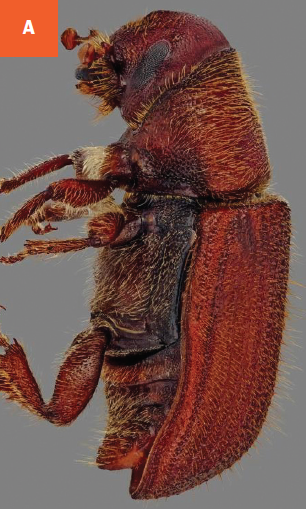Mountain Pine Beetle
Dendroctonus ponderosae
HOST Pine, Douglas-fir, fir, spruce
DAMAGE/SYMPTOMS Needles from infested trees turn a reddish-brown. Boring dust next to the tree is also a sign of infestation. Pink popcorn-like resin spots are often on the trunk.
LIFE CYCLE Mountain pine beetle adults are active in June and move to new trees in July through August. Females lay eggs under the bark. The larvae spend the winter developing in the phloem of the tree, forming distinct galleries. There is one generation per year, and beetle outbreaks occur every 10 to 30 years.
MANAGEMENT Once bark beetles enter the tree, the trees are not likely to survive. One preventive treatment option to protect healthy trees from attack is verbenone pine beetle repellent, which is an anti-aggregation pheromone. The verbenone pouches should be applied prior to beetle flight, which can be as early as late May in some locations. The pouches are only effective for one season and need to be replaced annually. A contact insecticide labeled for the host (active ingredients carbaryl, permethrin, and bifenthrin) can also be applied as a trunk spray in June through August (according to the label) for preventive measures on healthy trees.
A Mountain pine beetle adult. B Pitch tubes from mountain pine beetle infestations. C Galleries on the bark from mountain pine beetle infestations.



